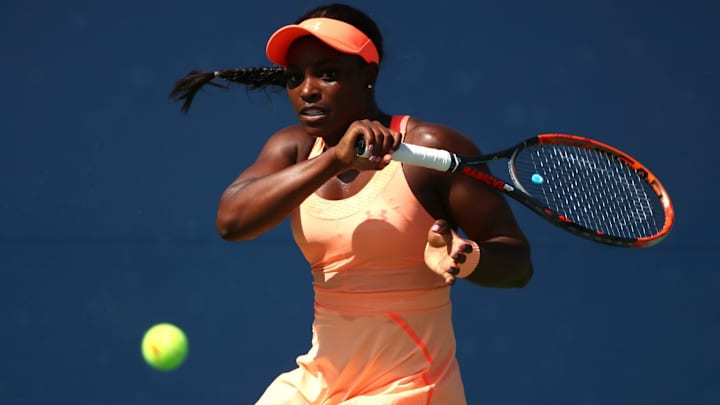How Sloane Stephens's Tennis Channel Gig Helped her During Injury Recovery

It’s hardly uncommon for athletes to spin their career success into a broadcasting job after retirement. But Sloane Stephens is doing just the opposite: Her brief spell as a Tennis Channel analyst played a small role in propelling her to the U.S. Open quarterfinals.
For several months during her recovery from foot surgery earlier this year, Stephens couldn’t walk, much less practice tennis. The operation, which stemmed from a stress fracture in her left foot, was the latest, most severe setback to a promising career for the 24-year-old American. But instead of completely disengaging from tennis, Stephens joined the sport’s flagship American television network as a contributing reporter, providing analysis during Indian Wells, Miami and Charleston.
Tennis World Congratulates Serena Williams on Birth of Her Child
Stephens broke through in 2013 when she reached the Australian Open semifinals and Wimbledon quarterfinals, but her progress stalled in 2014. The following year, she won her first career title at the Citi Open in Washington, D.C., and she won three more titles in 2016. But she withdrew from the U.S. Open because of a foot injury, which derailed the rest of her season, ultimately keeping her out until Wimbledon 2017. Her ranking fell outside the top 900.
The recovery process after a serious injury can be lonely for any athlete. Spanish soccer star Andres Iniesta wrote in his autobiography that he was overcome with “not depression, exactly, not illness, but an unease” as he recovered from a thigh injury in 2009. During Stephens’s recovery, she was forced to wear a “peg leg,” a burdensome leg brace, and later, a walking boot. But Stephens’s brief time as a Tennis Channel commentator kept her close to the sport.
Perhaps even more importantly, at a challenging juncture, she was able to spend time with tennis greats like Lindsay Davenport, Paul Annacone, Tracy Austin and Mary Carillo, all Tennis Channel analysts.
“I had such a good time being able to spend a month with Paul, Tracy, Lindsay and Mary,” Stephens told reporters in Washington, D.C. last month. “...I was in a very sad place in my life. I had a big boot on and a huge walking thing, and it was just not fun. They made it a really good time for me. It was actually the highlight of my year so far."
Former and current athletes are regularly featured as television analysts. The broadcast booth offers players a chance to step back and view the sport more holistically.
“The work with us actually reflected a time when she was seeing what was happening but not able to go out and play,” Annacone, who previously coached Stephens, told SI. “So I think in a lot of ways it maybe lit a fire a little bit, gave her a different kind of perspective.”
Congrats to @SloaneStephens as she heads into the QFs! 👏 #USOpen @MBUSA pic.twitter.com/WilkiMzYI7
— US Open Tennis (@usopen) September 3, 2017
Stephens says she didn’t ask her fellow Tennis Channel analysts for advice during her brief time at the network. But being in the presence of experienced veterans of the sport has perks.
“We just talked about game styles and matches. Obviously after a match went off, we would interview a player, this and that,” Stephens said Sunday. “It was more of a fun thing that a serious learning, teaching type of moment. It was more—I’m still around tennis and having fun. I get to hang with Paul and Lindsay and everyone.”
Annacone says he was impressed with Stephens’s patience in the face of a long recovery from injury. Her stoicism has paid off: Stephens beat several top players, including Petra Kvitova twice and Angelique Kerber, in the weeks preceding the U.S. Open, and she has ousted Roberta Vinci, Dominika Cibulkova, Ashleigh Barty and Julia Goerges—all top 50 players—so far in Flushing Meadows. Stephens will face Anastasia Sevastova, who beat Maria Sharapova in the round of 16, on Tuesday in her first U.S. Open quarterfinal.
Two of the Most Inspiring Stories in Tennis Will Meet in the U.S. Open Quarterfinals
“I think in some ways as an athlete, when you go through stuff in your career and you can see your mortality a little bit, it kind of helps,” Annacone said. “I think she had a big flash of a reality check which made her miss the game and which also gave her the opportunity to take a step back.”
Stephens’s journey to the second week of the U.S. Open required months of extraordinarily difficult rehabilitation, patience and practice. But her time at Tennis Channel, brief as it was, kept her focused on her sport just as it was challenging her the most.
“We talked about tennis all day long,” Stephens said. “There’s really nothing better.”
